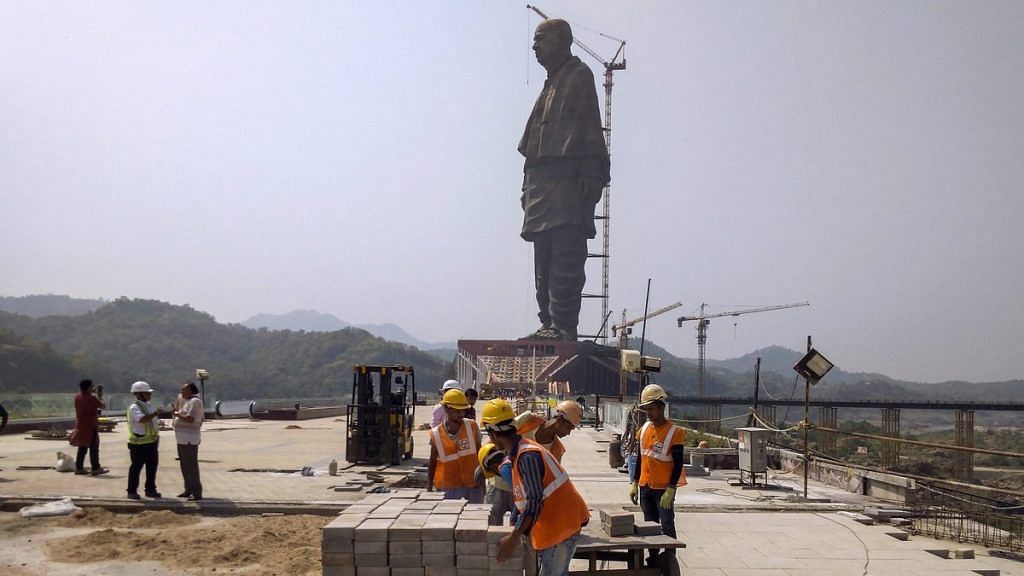Modi govt released ‘Incredible India’ ad on the ‘Statue of Unity’, reminding the younger generation about Patel’s contributions and how he ‘united’ India.
New Delhi: A 182-metre tall statue of Sardar Vallabhbhai Patel, independent India’s first home minister, has taken the centrestage of BJP’s politics, which is trying to fine-tune its strategy for outreach to various castes and communities.
Touted as the tallest statue in the world, the ‘Statue of Unity’ will be unveiled by Prime Minister Narendra Modi on Patel’s birth anniversary on 31 October near the Sardar Sarovar dam in Gujarat’s Narmada district.
For the ruling BJP, this is the party’s tribute to what it claims to be a hero forgotten by the Congress.
Also read: Gujarat’s ‘Statue of Unity’ district divided over how much they benefit from Sardar Sarovar Dam
The Modi government released a two-minute video under the ‘Incredible India’ campaign over the weekend, reminding the younger generation about Patel’s contributions and how he “united” India. It also underlined the fact the country has given Patel nothing in return, hinting at how the Congress has ignored him.
The ad also seeks to portray that it is the Modi-led BJP government which is now giving him his due, and how this will also help boost tourism in the country.
Incidentally, while the length of the statue is 182 m, the number of assembly seats in Gujarat is also 182.
The BJP’s emphasis on Patel and this tribute to him have multiple underlying political undertones and electoral calculations.
Appropriating Sardar Patel
Critical of the Congress’ focus on just the Nehru-Gandhi family, the BJP has attempted to appropriate the more conservative strand of the Congress, including leaders such as Patel and Madan Mohan Malaviya, since it came to power.
Traditionally, the BJP’s stand has been pro-Patel and anti-Nehru, claiming that while Nehru represented the westernised elite that was distant from Indian roots, Patel is symbolic of the hard muscular state with strong Hindu roots that India should have been.
According to top sources in the BJP, the ‘Statue of Unity’ has been “PM Modi’s personal project” and he has “consistently monitored its progress to ensure it is completed in five years”.
In 2013, as Gujarat’s chief minister Modi had himself laid the foundation stone of the project while bringing in veteran BJP leader L.K. Advani to do the bhoomi pujan. The BJP had collected iron, soil and water from across the country to go into building the statue.
Symbolically, this is Modi’s way of ensuring those outside the Nehru-Gandhi dynasty get due recognition, and he gets the credit for doing so, sources say.
Electoral significance — the Patel community
In the 2017 Gujarat assembly elections, the one factor that cost the BJP dear was the Patel agitation. The party’s slide, especially in the Saurashtra region, was a direct result of an angry Patel vote bank, which has been demanding reservations, with particularly the young Patel voter choosing to not support the BJP.
The influential community is crucial to the BJP’s electoral fortunes not just in the state elections, but also in the Lok Sabha polls, due next year. Gujarat has 26 Lok Sabha seats, of which the BJP won all in the 2014 elections.
“The Patel vote was severely dented in 2017. The idea behind the grand statue is to appeal to the community, especially the younger Patels ,” said a BJP source who did not wish to be identified.
“It also helps reach out to the very influential Patel diaspora, which has key networks and can help boost the BJP’s fortunes,” the source added.
Patels or Patidars make up for roughly 14 per cent of the state’s population, a considerable chunk.
The BJP also hopes to sell this unique statue as a high-point of the state’s tourist attractions, a fact it believes can help generate revenue and employment, and thus, further cement its hold among the state’s youth.
Outreach to farmers
The BJP’s emphasis on Sardar Patel isn’t just to play on his caste, but also his farmer origin. Patel was born into a farmer family and by throwing its weight behind him, the BJP hopes to reach out to the farmer community and claim to be highlighting their own.
In Gujarat itself, the party hopes this move will be of significance, given how farmer anger over inadequate prices for cotton and groundnut produce, again affected it adversely in the 2017 polls.
Also read: The BJP wants to rewrite history so that its politics can be all about ideology
However, the appeal to the farmer community has larger national resonance. Since coming to power in 2014, the Modi government has attempted to cultivate a pro-farmer image, launching several programmes for the farming and rural sector.
The party has been greatly worried about farmer anger in different parts of the country, including Rajasthan and Madhya Pradesh, that go to polls by year-end.
In fact, just last week, PM Modi unveiled a 64-ft statue of Jat legend Sir Chhotu Ram in Haryana’s Rohtak, hoping to pander to the influential Jat community as well as farmers.
